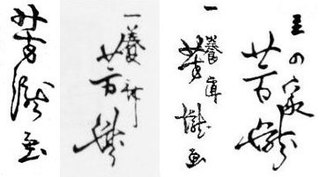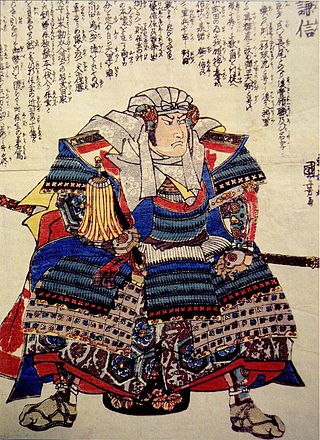Gallery
- The Story of Kyoyu and Sofu, ishizuri-e by Okumura Masanobu, c. 1750
- Poet Kakinomoto Hitomaro by Okumura Masanobu, c. 1740s
- Chrysanthemum by Katsushika Taito I, c. 1830
- Hiroshige, c. 1840
An ishizuri-e (石摺絵) is a Japanese woodblock print that mimics a stone rubbing. It has uninked images or text on a dark, usually black, background.
Okumura Masanobu was a Japanese print designer, book publisher, and painter. He also illustrated novelettes and in his early years wrote some fiction. At first his work adhered to the Torii school, but later drifted beyond that. He is a figure in the formative era of ukiyo-e doing early works on actors and bijin-ga.

Utagawa Yoshiiku, also known as or Ochiai Yoshiiku, was a Japanese artist of the Utagawa school.

Eishōsai Chōki, also known as Momokawa Chōki, was a designer of ukiyo-e style Japanese woodblock prints who was active from about 1786 to 1808. He, along with Utamaro, was a pupil of Toriyama Sekien (1712–1788). Chōki is best known for his pictures of beautiful slender women (bijin-ga), often with atmospheric backgrounds.
Ukiyo-e artists may be organized into schools, which consist of a founding artist and those artists who were taught by or strongly influenced by him. Artists of the Osaka school are united both stylistically and geographically. Not all of these artists designed woodblock prints, and some ukiyo-e artists had more than one teacher, and others are not known to be associated with any particular school.
Utagawa Hirokage, also known as Ichiyūsai Hirokage, was a Japanese designer of ukiyo-e woodblock prints, who was active from about 1855 to 1865. He was a pupil of Utagawa Hiroshige I. From 1860 to 1861, Hirokage designed the series of ōban size prints titled Edo meisho dōke zukushi. His reputation is based primarily upon this series and his 1859 triptych Aomono sakana gunzei daikassen no zu.

Katsukawa Shunsen, who is also known as Shunkō II, was a designer of books and ukiyo-e style Japanese woodblock prints. He was born in 1762 and designed prints from about 1805 to about 1821. He initially studied with the Rimpa school artist Tsutsumi Tōrin III. In 1806 or 1807, Shunsen became a student of Katsukawa Shun'ei, and changed his name from “Kojimachi Shunsen” to “Katsukawa Shunsen”. In 1820 he succeeded Katsukawa Shunkō I, becoming Katsukawa Shunkō II. In the late 1820s, he ceased producing woodblock prints and devoted himself to painting ceramics. He died about 1830.

Sawa Sekkyōwas a designer of ukiyo-e Japanese woodblock prints in the late 18th and early 19th centuries. He was originally a pupil of Tsutsumi Tōrin a painter of the Kanō school, but left the school and became an independent ukiyo-e artist. Sekkyō is best known for his landscapes and bird-and-animal studies, the latter often printed entirely in black or blue ink (aizuri-e).

Utagawa Yoshitora was a designer of ukiyo-e Japanese woodblock prints and an illustrator of books and newspapers who was active from about 1850 to about 1880. He was born in Edo, but neither his date of birth nor date of death is known. However, he was the oldest pupil of Utagawa Kuniyoshi who excelled in prints of warriors, kabuki actors, beautiful women, and foreigners (Yokohama-e). He may not have seen any of the foreign scenes he depicted.
Yokohama-e are Japanese woodblock prints depicting non-East Asian foreigners and scenes in the port city of Yokohama.

Utagawa Yoshitsuya, also known as Kōko Yoshitsuya (甲胡 芳艶) and as Ichieisai Yoshitsuya (一英斎 芳艶), was a Japanese designer of ukiyo-e woodblock prints.

Utagawa Yoshitaki, who is also known as Ichiyōsai Yoshitaki, was a Japanese designer of ukiyo-e woodblock prints who was active in both Edo (Tokyo) and Osaka. He was also a painter and newspaper illustrator. His father was a paste merchant, and Yoshitaki became a student of Utagawa Yoshiume (1819–1879). Yoshitaki was the most prolific designer of woodblock prints in Osaka from the 1860s to the 1880s, producing more than 1,200 different prints, almost all of kabuki actors.

Urakusai Nagahide, was a designer of ukiyo-e style Japanese woodblock prints who was active from about 1804 to about 1848. He is also known as Yūrakusai Nagahide (有楽斎 長秀), Nakamura Nagahide, Chōshū (長秀), and as Chōshūsai (長秀斎). “Nagahide” and “Chōshū” are written with the same kanji. The ending “sai” means studio or hall, and is added or omitted at will by many Japanese artists.
Benizuri-e are a type of "primitive" ukiyo-e style Japanese woodblock prints. They were usually printed in pink (beni) and green, occasionally with the addition of another color, either printed or added by hand.

Shunbaisai Hokuei, also known as Shunkō III, was a designer of ukiyo-e style Japanese woodblock prints in Osaka, and was active from about 1824 to 1837. He was a student of Shunkōsai Hokushū. Hokuei’s prints most often portray the kabuki actor Arashi Rikan II.

Shunkōsai Hokushū (春好斎 北洲), who is also known as Shunkō IV, was a designer of ukiyo-e style Japanese woodblock prints in Osaka who was active from about 1802 to 1832. He is known to have been a student of Shōkōsai Hambei, and may have also studied with Hokusai. He used the name Shunkō (春好) until 1818, when he changed his name to Shunkōsai Hokushū. He was the most important artist in Osaka during the 1810s and 1820s and established the Osaka style of actor prints.

Ryūkōsai Jokei was a painter, illustrator, and designer of ukiyo-e-style Japanese woodblock prints in Osaka, who was active from about 1777 to 1809. He was a student of Shitomi Kangetsu (1747–1797), who in turn was the son and pupil of Tsukioka Settei (1710–1786). Ryūkōsai is considered to be either the founder or one of the founders of the Osaka school of ukiyo-e. He is best known for his portraits of actors. His prints are mostly in the hosoban format.

Uki-e refers to a genre of ukiyo-e pictures that employs western conventions of linear perspective. Although they never constituted more than a minor genre, pictures in perspective were drawn and printed by Japanese artists from their introduction in the late 1730s through to the mid-nineteenth century.
An aka-e is a type of ukiyo-e that is printed entirely or predominantly in red. Aka-e were said to be talismans against smallpox, especially when they bore images of Shōki the demon queller. A woodblock print having a significant portion of the design entirely in red may also be considered to be an aka-e.

Nishimura Shigenaga was a Japanese ukiyo-e artist.

Musha-e (武者絵) is a type a Japanese art that was developed in the late 18th century. It is a genre of the ukiyo-e woodblock printing technique, and represents images of warriors and samurai from Japanese history and mythology.
![]() Media related to Ishizuri-e at Wikimedia Commons
Media related to Ishizuri-e at Wikimedia Commons